Michael Swanwick's Blog, page 171
March 28, 2013
An Important Message
.
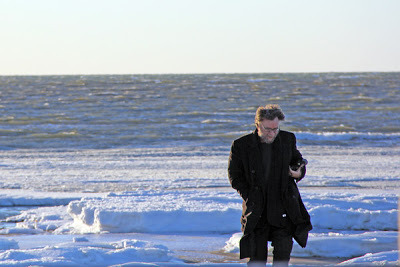
I have come down from the North to tell you this:
Despite all appearances, Spring is on its way.
It's almost here.
Don't lose hope.
Above: Photo copyright by Robert Price and used with his permission.
*

I have come down from the North to tell you this:
Despite all appearances, Spring is on its way.
It's almost here.
Don't lose hope.
Above: Photo copyright by Robert Price and used with his permission.
*
Published on March 28, 2013 14:54
March 27, 2013
Is The Left Hand of Darkness Sexist?
.
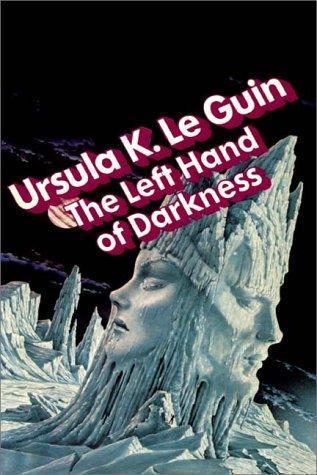
Twelve years ago, give or take a few, Gregory Frost and I guest taught one of Judith Moffett's science fiction classes. This was back when she was at the U of P. It was a good class. The experience was satisfying to everyone involved. Then, after the class, two of the female students approached Greg and me with a question that was obviously burning in them: "What do you think of The Left Hand of Darkness ?" Which was a strange question because Judith worshiped at the altar of Le Guin specifically because of that novel and we were sure she'd taught it intensely. Hell, in person she could hardly stop talking about it.
"We think it's a very great book," Greg said.
I nodded. "Why? What do you think about it?"
They looked embarrassed. Then one of them said, "We think it's sexist."
To say that the male components of this exchange were flabbergasted is an understatement. But we did as well as we could in the conversation that ensued to put the book into perspective in a way that did not condescend to either Le Guin or her young readers.
Time passed.
Recently, I wanted to re-read a specific section of LHoD and discovered that I was no longer satisfied with the copy I'd owned for decades, a coverless paperback bought back when I had far more reading time than money. Time has reversed those proportions and so I bought a hardcover.
Behold the (admittedly still partial) triumph of feminism: Now I can see what those students were talking about.
Take a look at the last full page of this work about a sexless culture, starting with Genly Ai's meeting with Therem's father. The male nouns and pronouns pop from the page: old man... he... his... son... old lord... brother... son... him... he... he... old man's... boy... heir of Estre, my son's son... boy... king... old lord... he... he... Lord Envoy... the boy, Therem's son...
And then the conclusion: "Will you tell us how he died?--Will you tell us about the other worlds among the stars--the other kinds of men, the other lives?"
It was as if the female pronoun and all related nouns had been banished. It was as if being male were the default position of humanity. It was as if women didn't count.
It seems so obvious now, forty-four years after the book's first publication. But the year before that, 1968, when Le Guin would have been writing the novel, I remember a friend (we were both freshmen at William & Mary then) who, crying and in extremis, drunkenly said, "Everybody says that men and women think differently -- but we don't! I think exactly the same way a man does." I could hear the truth in her voice. But I was baffled by it. Everybody knew that men and women thought differently. All our literature said so. Every woman I'd ever known said so. My mother said so.
And here was a woman saying: No. It's not so.
I didn't know what to make of it. I thought about it for years, trying to understand it.
That was the world in which Le Guin wrote The Left Hand of Darkness. Which had at its core what then seemed to almost everyone to be an obvious untruth: Men and women are in essence the same .
What an extraordinary work for a woman of her times to have written! Le Guin must have known, as she was writing it, that she was working on a novel that might well have been beyond her capabilities. How astonished we were by it when it came out!
What a triumph for her that nowadays even a male reader can wonder, if only for a moment, if it's sexist.
*

Twelve years ago, give or take a few, Gregory Frost and I guest taught one of Judith Moffett's science fiction classes. This was back when she was at the U of P. It was a good class. The experience was satisfying to everyone involved. Then, after the class, two of the female students approached Greg and me with a question that was obviously burning in them: "What do you think of The Left Hand of Darkness ?" Which was a strange question because Judith worshiped at the altar of Le Guin specifically because of that novel and we were sure she'd taught it intensely. Hell, in person she could hardly stop talking about it.
"We think it's a very great book," Greg said.
I nodded. "Why? What do you think about it?"
They looked embarrassed. Then one of them said, "We think it's sexist."
To say that the male components of this exchange were flabbergasted is an understatement. But we did as well as we could in the conversation that ensued to put the book into perspective in a way that did not condescend to either Le Guin or her young readers.
Time passed.
Recently, I wanted to re-read a specific section of LHoD and discovered that I was no longer satisfied with the copy I'd owned for decades, a coverless paperback bought back when I had far more reading time than money. Time has reversed those proportions and so I bought a hardcover.
Behold the (admittedly still partial) triumph of feminism: Now I can see what those students were talking about.
Take a look at the last full page of this work about a sexless culture, starting with Genly Ai's meeting with Therem's father. The male nouns and pronouns pop from the page: old man... he... his... son... old lord... brother... son... him... he... he... old man's... boy... heir of Estre, my son's son... boy... king... old lord... he... he... Lord Envoy... the boy, Therem's son...
And then the conclusion: "Will you tell us how he died?--Will you tell us about the other worlds among the stars--the other kinds of men, the other lives?"
It was as if the female pronoun and all related nouns had been banished. It was as if being male were the default position of humanity. It was as if women didn't count.
It seems so obvious now, forty-four years after the book's first publication. But the year before that, 1968, when Le Guin would have been writing the novel, I remember a friend (we were both freshmen at William & Mary then) who, crying and in extremis, drunkenly said, "Everybody says that men and women think differently -- but we don't! I think exactly the same way a man does." I could hear the truth in her voice. But I was baffled by it. Everybody knew that men and women thought differently. All our literature said so. Every woman I'd ever known said so. My mother said so.
And here was a woman saying: No. It's not so.
I didn't know what to make of it. I thought about it for years, trying to understand it.
That was the world in which Le Guin wrote The Left Hand of Darkness. Which had at its core what then seemed to almost everyone to be an obvious untruth: Men and women are in essence the same .
What an extraordinary work for a woman of her times to have written! Le Guin must have known, as she was writing it, that she was working on a novel that might well have been beyond her capabilities. How astonished we were by it when it came out!
What a triumph for her that nowadays even a male reader can wonder, if only for a moment, if it's sexist.
*
Published on March 27, 2013 00:00
March 25, 2013
Hemingway Speaks from the Mountaintop
.

There were two Hemingways. One was Papa, the macho, boisterous, lion-shooting, Cuba-libre-swilling, bullfight-chronicling, sports-fishing parody of himself. This is a guy you'd like to be. The other was Ernest, the serious writer who was a fine craftsman and set an extremely high standard for himself. Only another writer would want to be him. And even then...
I just now ran across something Hemingway wrote (not said; it was near the end of his life and he was in no shape to go to Stockholm so he asked the US ambassador to accept for him) in his Nobel Prize acceptance speech:
If you're a new or gonnabe writer, I want you to take those words to heart. And because you're a writer and thus have a particular genius for not hearing things you don't want to hear, I'll put what the man said in even simpler words:
Writing well is not enough to make your work last. Retelling somebody else's story in flashier or leaner or "better" prose is not enough to make your work last. You've got to go beyond what anybody else has ever said before in order to have a shot. Worse, you've got to go beyond what you think you're capable of if you want to have the slightest ghost of a chance of your work enduring.
Even if you succeed, your work may not endure. But if you don't even try... well, it was your own decision to fail.
Here endeth the sermon. Children, go and sin no more.
*

There were two Hemingways. One was Papa, the macho, boisterous, lion-shooting, Cuba-libre-swilling, bullfight-chronicling, sports-fishing parody of himself. This is a guy you'd like to be. The other was Ernest, the serious writer who was a fine craftsman and set an extremely high standard for himself. Only another writer would want to be him. And even then...
I just now ran across something Hemingway wrote (not said; it was near the end of his life and he was in no shape to go to Stockholm so he asked the US ambassador to accept for him) in his Nobel Prize acceptance speech:
How simple the writing of literature would be if it were only necessary to write in another way what has been well written. It is because we have had such great writers in the past that a writer is driven far out past where he can go, out to where no one can help him.
If you're a new or gonnabe writer, I want you to take those words to heart. And because you're a writer and thus have a particular genius for not hearing things you don't want to hear, I'll put what the man said in even simpler words:
Writing well is not enough to make your work last. Retelling somebody else's story in flashier or leaner or "better" prose is not enough to make your work last. You've got to go beyond what anybody else has ever said before in order to have a shot. Worse, you've got to go beyond what you think you're capable of if you want to have the slightest ghost of a chance of your work enduring.
Even if you succeed, your work may not endure. But if you don't even try... well, it was your own decision to fail.
Here endeth the sermon. Children, go and sin no more.
*
Published on March 25, 2013 06:12
March 23, 2013
Print + Paper Three Potato Four
.
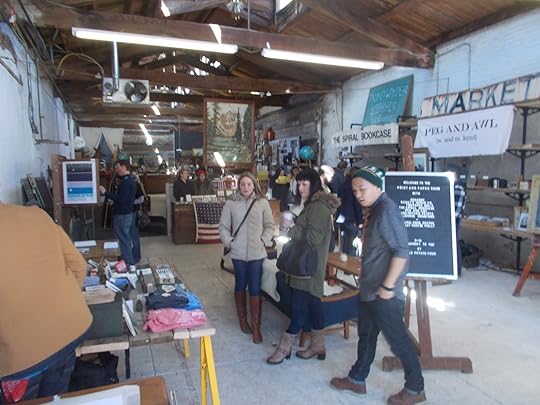
I rarely blog on weekends. But today I went to the Print + Paper Show at Three Potato Four on Shurs Lane here in Roxborough. I liked it. It runs through Sunday. If you're local, you mmight give it a try.
You can find out about it at the 3P4 blog.
*

I rarely blog on weekends. But today I went to the Print + Paper Show at Three Potato Four on Shurs Lane here in Roxborough. I liked it. It runs through Sunday. If you're local, you mmight give it a try.
You can find out about it at the 3P4 blog.
*
Published on March 23, 2013 17:59
March 22, 2013
Jay DeFeo's Rose -- and the Lesson We Should Learn From It
.
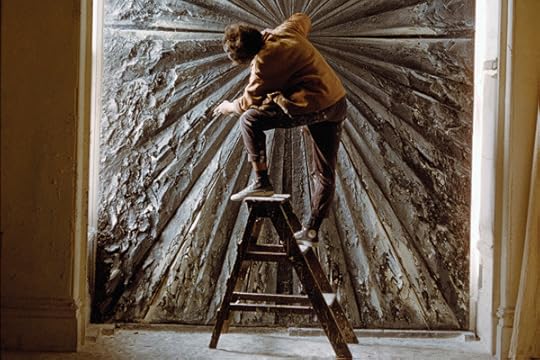
How powerful is a story? An article in the New Yorker about the artist Jay DeFeo sent me to the Whitney yesterday, to the first comprehensive overview of her work and life.
In brief: DeFeo was recognized as an artist of brilliance straight out of art school. Her stuff was good from the git-go. It got better and better, culminating in a group of large encaustic religious abstracts -- Veronica, The Jewel, Annunciation, and Incision -- which, for my money, established her as a great artist. Go and look at them, if you doubt me.
Then she started painting Deathrose (later The White Rose and finally The Rose), a culminative work which was meant to express something profound and spiritual.
She worked on it for nine years, building up boulders of paint and scraping them back down, sometimes right to the canvas. The only reason that she didn't keep on working on it until her death was that her landlord raised the rent, forcing her to move out. Also to have a wall torn out so her masterwork could be removed by crane.
This was an emotional time for DeFeo. She lost her husband, contracted gum disease, and stopped working.
For four years.
DeFeo eventually pulled herself together and proceeded to create work that was consistently interesting and often profound to her dying day. But consider this: She was a peer of Jasper Johns, Helen Frankenthaler, Ellsworth Kelly, Robert Rauschenberg a other artists who are household names today. Yet she is not.
The Rose is good, but overworked. The oils leading up to it are great. If DeFeo had refrained from obsessing over it, she might have produced a great work. At worst, it would have been a flop, which would have been quickly forgotten.
But DeFeo forged on, obsessively, trying to create something better than she was capable of, and in the course of it destroyed her career.
The moral, as it applies to writers, is, I hope, obvious.
*

How powerful is a story? An article in the New Yorker about the artist Jay DeFeo sent me to the Whitney yesterday, to the first comprehensive overview of her work and life.
In brief: DeFeo was recognized as an artist of brilliance straight out of art school. Her stuff was good from the git-go. It got better and better, culminating in a group of large encaustic religious abstracts -- Veronica, The Jewel, Annunciation, and Incision -- which, for my money, established her as a great artist. Go and look at them, if you doubt me.
Then she started painting Deathrose (later The White Rose and finally The Rose), a culminative work which was meant to express something profound and spiritual.
She worked on it for nine years, building up boulders of paint and scraping them back down, sometimes right to the canvas. The only reason that she didn't keep on working on it until her death was that her landlord raised the rent, forcing her to move out. Also to have a wall torn out so her masterwork could be removed by crane.
This was an emotional time for DeFeo. She lost her husband, contracted gum disease, and stopped working.
For four years.
DeFeo eventually pulled herself together and proceeded to create work that was consistently interesting and often profound to her dying day. But consider this: She was a peer of Jasper Johns, Helen Frankenthaler, Ellsworth Kelly, Robert Rauschenberg a other artists who are household names today. Yet she is not.
The Rose is good, but overworked. The oils leading up to it are great. If DeFeo had refrained from obsessing over it, she might have produced a great work. At worst, it would have been a flop, which would have been quickly forgotten.
But DeFeo forged on, obsessively, trying to create something better than she was capable of, and in the course of it destroyed her career.
The moral, as it applies to writers, is, I hope, obvious.
*
Published on March 22, 2013 00:00
Jan Defeo's Rose -- and the Lesson We Should Learn From It
.

How powerful is a story? An article in the New Yorker about the artist Jay DeFeo sent me to the Whitney yesterday, to the first comprehensive overview of her work and life.
In brief: DeFeo was recognized as an artist of brilliance straight out of art school. Her stuff was good from the git-go. It got better and better, culminating in a group of large encaustic religious abstracts -- Veronica, The Jewel, Annunciation, and Incision -- which, for my money, established her as a great artist. Go and look at them, if you doubt me.
Then she started painting Deathrose (later The White Rose and finally The Rose), a culminative work which was meant to express something profound and spiritual.
She worked on it for nine years, building up boulders of paint and scraping them back down, sometimes right to the canvas. The only reason that she didn't keep on working on it until her death was that her landlord raised the rent, forcing her to move out. Also to have a wall torn out so her masterwork could be removed by crane.
This was an emotional time for DeFeo. She lost her husband, contracted gum disease, and stopped working.
For four years.
DeFeo eventually pulled herself together and proceeded to create work that was consistently interesting and often profound to her dying day. But consider this: She was a peer of Jasper Johns, Helen Frankenthaler, Ellsworth Kelly, Robert Rauschenberg a other artists who are household names today. Yet she is not.
The Rose is good, but overworked. The oils leading up to it are great. If DeFeo had refrained from obsessing over it, she might have produced a great work. At worst, it would have been a flop, which would have been quickly forgotten.
But DeFeo forged on, obsessively, trying to create something better than she was capable of, and in the course of it destroyed her career.
The moral, as it applies to writers, is, I hope, obvious.
*

How powerful is a story? An article in the New Yorker about the artist Jay DeFeo sent me to the Whitney yesterday, to the first comprehensive overview of her work and life.
In brief: DeFeo was recognized as an artist of brilliance straight out of art school. Her stuff was good from the git-go. It got better and better, culminating in a group of large encaustic religious abstracts -- Veronica, The Jewel, Annunciation, and Incision -- which, for my money, established her as a great artist. Go and look at them, if you doubt me.
Then she started painting Deathrose (later The White Rose and finally The Rose), a culminative work which was meant to express something profound and spiritual.
She worked on it for nine years, building up boulders of paint and scraping them back down, sometimes right to the canvas. The only reason that she didn't keep on working on it until her death was that her landlord raised the rent, forcing her to move out. Also to have a wall torn out so her masterwork could be removed by crane.
This was an emotional time for DeFeo. She lost her husband, contracted gum disease, and stopped working.
For four years.
DeFeo eventually pulled herself together and proceeded to create work that was consistently interesting and often profound to her dying day. But consider this: She was a peer of Jasper Johns, Helen Frankenthaler, Ellsworth Kelly, Robert Rauschenberg a other artists who are household names today. Yet she is not.
The Rose is good, but overworked. The oils leading up to it are great. If DeFeo had refrained from obsessing over it, she might have produced a great work. At worst, it would have been a flop, which would have been quickly forgotten.
But DeFeo forged on, obsessively, trying to create something better than she was capable of, and in the course of it destroyed her career.
The moral, as it applies to writers, is, I hope, obvious.
*
Published on March 22, 2013 00:00
March 20, 2013
Bristlebots!
.
When Sean was a little boy, he and I took a cigar box, some powered wheels, a coat hanger and a superball and built a robot with one bit of processing power. Not byte -- bit. I was pretty proud of that, and figured that we'd just set a record that would last forever.
I was wrong.
A bristlebot is a robot with zero processing power. It's made by taping the motor from a pager and a watch battery to the back of a severed toothbrush head. Let it go and it skitters around randomly. So far, pure motion, no robotic behavior.
When placed in a confined space, the bristlebots continue to move about randomly. However, when they take up at least 8 percent of the space's area, swarming behavior emerges.
The above video explains it all. But if you want to cut to the emergent behavior, skip ahead to 1:27.
*
When Sean was a little boy, he and I took a cigar box, some powered wheels, a coat hanger and a superball and built a robot with one bit of processing power. Not byte -- bit. I was pretty proud of that, and figured that we'd just set a record that would last forever.
I was wrong.
A bristlebot is a robot with zero processing power. It's made by taping the motor from a pager and a watch battery to the back of a severed toothbrush head. Let it go and it skitters around randomly. So far, pure motion, no robotic behavior.
When placed in a confined space, the bristlebots continue to move about randomly. However, when they take up at least 8 percent of the space's area, swarming behavior emerges.
The above video explains it all. But if you want to cut to the emergent behavior, skip ahead to 1:27.
*
Published on March 20, 2013 00:00
March 19, 2013
William Gaddis
.
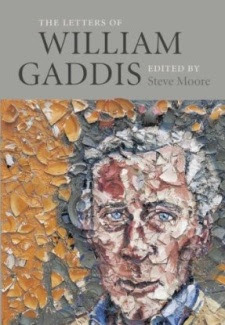
In 1987, my friend James Cappio drafted a legal opinion which led to him meeting William Gaddis.
Now Jim has written an account detailing the experience. I love everything about his essay, right down to the name of the lawsuit that precipitated it.
Click here to find out what I'm enthusing about.
Above: This book features in the account.
*

In 1987, my friend James Cappio drafted a legal opinion which led to him meeting William Gaddis.
Now Jim has written an account detailing the experience. I love everything about his essay, right down to the name of the lawsuit that precipitated it.
Click here to find out what I'm enthusing about.
Above: This book features in the account.
*
Published on March 19, 2013 00:00
March 18, 2013
Where DO I Get My Ideas?
.

I have to confess to having a streak of lowbrow in my appreciation of the visual arts. I'm a big fan of the highbrow stuff, mind you. But like most writers I have a weakness for narrative art. Sometimes I'll get story ideas from it. Other times, I'll even impose a narrative on artworks where it doesn't properly belong. "A Midwinter's Tale" was based on a show of Marc Chagall's paintings, for instance, and "The Blind Minotaur" was derived from Pablo Picasso's Vollard Suite.
Yesterday I went to the Brandywine River Museum to see a show assembling sketches and watercolors that Andrew Wyeth painted and drew in the process of putting together a painting called The Ides of March . (It would be a violation of copyright for me to post an image of the painting here, but you can find it easily enough on the Web, if you're curious.)
One watercolor fascinated me: an untitled sketch of a wood fire burned down to embers. It's a bravura piece of work showing nothing but the wood, charred to carbon mostly, though one stick is half-unburnt and white as a bone. Smoke pulls away from it at one end. Here and there, the embers burn bright. It's a magnificent piece of observation. Which fact is pointed up by a nearby watercolor of a fire painted by the great illustrator Howard Pyle; an excellent work, but not as good as Wyeth's.
I kept coming back to that one piece. It made me want to describe a fire with similar care. Then it made me want to write a story that would be contained within that careful description. By the time I left, I was sure there was something there.
The tentative title for the story is, "Embers Hissing and Popping, Sparks Flying Up." I've got some thoughts about what it's about. Someday I'll come up with a first line. Someday later, I'll come up with a last line. Then I'll start writing. My best guess is that it should be done sometime within the next five years.
Nobody ever asks me where I get my ideas. But if they did, this would be my answer.
And, oh yeah . . .
I should probably mention that I'd just read a fantasy story which I thought got Faerie absolutely and completely wrong and which made me want to write something that would do it right. So there's a touch of competitiveness that goes into the mix as well.
Above: Stones in the Brandywine River Museum's courtyard.
*

I have to confess to having a streak of lowbrow in my appreciation of the visual arts. I'm a big fan of the highbrow stuff, mind you. But like most writers I have a weakness for narrative art. Sometimes I'll get story ideas from it. Other times, I'll even impose a narrative on artworks where it doesn't properly belong. "A Midwinter's Tale" was based on a show of Marc Chagall's paintings, for instance, and "The Blind Minotaur" was derived from Pablo Picasso's Vollard Suite.
Yesterday I went to the Brandywine River Museum to see a show assembling sketches and watercolors that Andrew Wyeth painted and drew in the process of putting together a painting called The Ides of March . (It would be a violation of copyright for me to post an image of the painting here, but you can find it easily enough on the Web, if you're curious.)
One watercolor fascinated me: an untitled sketch of a wood fire burned down to embers. It's a bravura piece of work showing nothing but the wood, charred to carbon mostly, though one stick is half-unburnt and white as a bone. Smoke pulls away from it at one end. Here and there, the embers burn bright. It's a magnificent piece of observation. Which fact is pointed up by a nearby watercolor of a fire painted by the great illustrator Howard Pyle; an excellent work, but not as good as Wyeth's.
I kept coming back to that one piece. It made me want to describe a fire with similar care. Then it made me want to write a story that would be contained within that careful description. By the time I left, I was sure there was something there.
The tentative title for the story is, "Embers Hissing and Popping, Sparks Flying Up." I've got some thoughts about what it's about. Someday I'll come up with a first line. Someday later, I'll come up with a last line. Then I'll start writing. My best guess is that it should be done sometime within the next five years.
Nobody ever asks me where I get my ideas. But if they did, this would be my answer.
And, oh yeah . . .
I should probably mention that I'd just read a fantasy story which I thought got Faerie absolutely and completely wrong and which made me want to write something that would do it right. So there's a touch of competitiveness that goes into the mix as well.
Above: Stones in the Brandywine River Museum's courtyard.
*
Published on March 18, 2013 09:15
March 15, 2013
Bootleg Romanticism
.
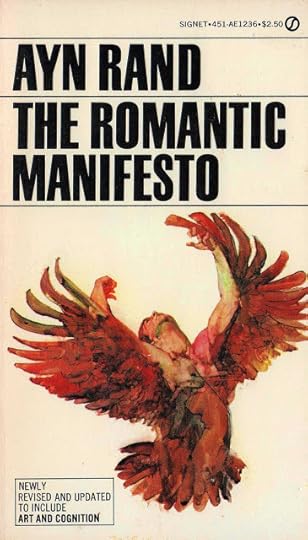
I just now read Ayn Rand's 1965 essay, "Bootleg Romanticism," not in a sardonic frame of mind but because the woman did write some very successful romantic melodramas which people bought in huge numbers despite the fact that they were punctuated by long essays about values, politics, and responsibility. One can disagree with her philosophy and still admire the craft of that.
The essay begins by claiming that "thrillers" (quotation marks hers) are a kind of bargain-basement, skeletal form of Romantic literature. That though lacking the literary quality of, say, Dostoyevsky, they deal with Man as an active agent of his (at the time, the convention of the male pronoun was universal, so let's not bust her chops over that) own fate, and deal with the issue of good versus evil.
So far, fine. She goes on to single out for praise Ian Fleming and Mickey Spillane. Not the exemplars of moral thrillers I would have chosen, but okay, I'm still listening, "Because they provide heroes," she writes. This is an argument that used to be common in science fiction and, I have to say, sounded just a touch jejeune even back then.
The bulk of the essay is taken up with a vigorous attack against the sort of thing she is opposed to and the sort of people who promote it:
Fierce words. But are they justified? Can they be proved? Will she name names? Halfway through the essay, the Enemy has yet to be identified. So far, there have been two quotations. One is a brief excerpt from a New York Times review of an unidentified movie. The other is a two-sentence synopsis of a Gunther Grass novel that had appeared in Time magazine. Nothing in her comments suggests she has seen the movie or read the book.
Now, at last, however, Rand gets down to source of her ire: An essay in TV Guide , praising a television show called . . . The Avengers. She is horrified to discover that it is meant to be a parody of James Bond. She is disgusted to learn that the show is meant to be a self-parody. (Italics hers.) There is nothing to suggest she has ever seen an episode.
Nevertheless, at this point Rand is confident that she has discredited James Joyce and Franz Kafka, both of whom are name-checked in the final sentence, though not a prior word was devoted to either before this, and so the essay may end.
As I said, I don't agree with Rand's philosophy. But I expected better of her than this.
Above: The cover of the book where I found the essay. Does anybody know the name of the artist? He/she did the covers of all the intellectually challenging and, often, polymorphously perverse, books back in the day.
*

I just now read Ayn Rand's 1965 essay, "Bootleg Romanticism," not in a sardonic frame of mind but because the woman did write some very successful romantic melodramas which people bought in huge numbers despite the fact that they were punctuated by long essays about values, politics, and responsibility. One can disagree with her philosophy and still admire the craft of that.
The essay begins by claiming that "thrillers" (quotation marks hers) are a kind of bargain-basement, skeletal form of Romantic literature. That though lacking the literary quality of, say, Dostoyevsky, they deal with Man as an active agent of his (at the time, the convention of the male pronoun was universal, so let's not bust her chops over that) own fate, and deal with the issue of good versus evil.
So far, fine. She goes on to single out for praise Ian Fleming and Mickey Spillane. Not the exemplars of moral thrillers I would have chosen, but okay, I'm still listening, "Because they provide heroes," she writes. This is an argument that used to be common in science fiction and, I have to say, sounded just a touch jejeune even back then.
The bulk of the essay is taken up with a vigorous attack against the sort of thing she is opposed to and the sort of people who promote it:
A seedy, emasculated, uneventilated 'elite' -- a basement 'elite' transported, by default, into vacant drawing rooms and barricaded behind dusty curtains against, light, air, grammar, and reality -- today's intellectuals cling to the stagnant illusion of their altruist-collectivist upbringing: the vision of a cloddish, humble, inarticulate people whose 'voice' (and masters) they were to be.
Fierce words. But are they justified? Can they be proved? Will she name names? Halfway through the essay, the Enemy has yet to be identified. So far, there have been two quotations. One is a brief excerpt from a New York Times review of an unidentified movie. The other is a two-sentence synopsis of a Gunther Grass novel that had appeared in Time magazine. Nothing in her comments suggests she has seen the movie or read the book.
Now, at last, however, Rand gets down to source of her ire: An essay in TV Guide , praising a television show called . . . The Avengers. She is horrified to discover that it is meant to be a parody of James Bond. She is disgusted to learn that the show is meant to be a self-parody. (Italics hers.) There is nothing to suggest she has ever seen an episode.
Nevertheless, at this point Rand is confident that she has discredited James Joyce and Franz Kafka, both of whom are name-checked in the final sentence, though not a prior word was devoted to either before this, and so the essay may end.
As I said, I don't agree with Rand's philosophy. But I expected better of her than this.
Above: The cover of the book where I found the essay. Does anybody know the name of the artist? He/she did the covers of all the intellectually challenging and, often, polymorphously perverse, books back in the day.
*
Published on March 15, 2013 00:30
Michael Swanwick's Blog
- Michael Swanwick's profile
- 546 followers
Michael Swanwick isn't a Goodreads Author
(yet),
but they
do have a blog,
so here are some recent posts imported from
their feed.



